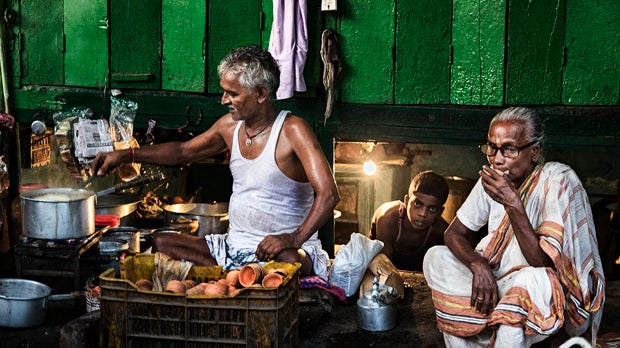Benefits and Burdens of Digital Retail Payments
Digitizing merchant payments presents a clear business opportunity. IFC and the World Bank estimate that in 2015 person-to-small-business payments totalled $930 billion in Sub-Saharan Africa alone, of which only 16 percent were electronic. If the share of digital payments increased to 50 percent, payments providers could earn nearly $7 billion, assuming a 1.5 percent average transaction fee.
But what are the opportunities for poor people?

In a recent post, my colleagues presented ideas on how to incentivize customers to make digital retail transactions. While this is an important goal — something of a holy grail in digital financial inclusion — we also need to consider the potentially negative impact that digital retail transactions could have on poor people, most of whom are financially excluded (it’s important to remember that 85 percent of poor households in low-income countries do not have a transaction account, as per the 2014 Findex data). This post reinforces my colleagues’ concerns about the risks of digital overdraft models and raises new questions about who would benefit from mobile money loyalty programs.
Overdraft services can erode household wealth
Better tools to smooth uneven income and manage negative shocks are important additions to a household’s financial toolkit. Credit, even if expensive, has a role to play in filling shortfalls. Aside from emergencies, relatively expensive credit could also make sense for lumpy investments that may not be used for productive purposes but nonetheless provide a return financially or materially.
But it’s critical to consider when it makes sense for low-income households to take on additional debt. According to a 2015 study from Ohio State University, expensive, short-term lending can negatively affect welfare and reduce consumption. A 2016 Federal Reserve Board report on high-cost credit specifies that the impact of these services is “state-dependent” — that is, short-term loans can help during emergencies by smoothing consumption but worsen well-being in normal times. Unfortunately, people don’t use these lending services only for emergencies but to finance predictable, recurring costs. Hence, borrowers risk ending up in a cycle of debt.
Injecting friction into the borrower’s decision process can mitigate risks of persistent indebtedness. For instance, taking out an M-Shwari loan requires several steps. This gives borrowers time to reflect on their ability to repay the loan and the impact that servicing this debt will have on their overall finances.
Rather than increasing these frictions, an overdraft or credit product for retail payments makes it easier to take on additional debt. Even if customers have the numeracy skills to understand pricing, behavioral biases can make it hard to determine if opting for an overdraft or loan makes sense financially since we tend to value immediate rewards over future costs.
Overdraft products and similarly structured loans are particularly dangerous because they are revolving, the terms are not usually well understood and customers may not even know when they’ve dipped into their overdraft facility. If using these products hurts poor people’s credit histories, it could impede their access to credit for things like education that would have higher returns.
Loyalty schemes carry a high price
While high rates of cash use impose costs to society nationally and globally, cash is often cheaper and more convenient than digital payments for merchants and customers at the transaction level. And since marginal costs of cash increase (unlike electronic payments), the cost comparison for small merchants with low transaction sizes would weigh even more heavily in favor of cash. Credit transactions have even higher per transaction costs than debit, since the issuer bears more risk. To cover their increased transaction costs, merchants compensate by levying a surcharge for customers paying electronically. While this practice is widespread in emerging markets today, that could change as more regulators ban surcharges as part of their efforts to increase digital payments. Payments providers looking to boost uptake might also start prohibiting surcharges through their service agreements with merchants. If that happens, merchants will likely raise prices for everyone, even those not paying digitally.
Loyalty schemes are a form of price discrimination. They offer the same product at different prices to different customers. While such schemes benefit customers who can navigate the programs and reach the necessary spending amounts, they can also hurt low-income customers. Since providers often increase prices to compensate for reward payments, poor people may end up paying for “loyalty” benefits that go mainly to higher-income customers.
A study from the Federal Reserve Bank of Boston on credit card rewards programs quantified the impact of increased prices (1.5 percent) and the benefits of rewards programs. The study showed that each cash-using household pays $149 annually to card-using households, while each card-using household receives $1,133 from cash users. Since card use correlates with income, the system facilitates a transfer of wealth from the poor to the rich. And since we know from Findex data and other sources that the financially excluded are more likely to be poor, rural and female, loyalty programs for mobile money could enable a similarly regressive subsidy.
Loyalty schemes can also undermine competition by hampering customers’ ability to compare prices, artificially increasing costs (or perceived costs) of switching providers and enabling tacit collusion. As digital financial services markets have monopolistic tendencies, the risks to competition from loyalty schemes are even greater, particularly if used by a provider with market dominance.
Externalities of cash: Whose burden?
Digital merchant payments offer many potential benefits. As several countries have found, digitization can reduce tax evasion, money laundering, crime and other negative externalities of cash that weaken national security and economic growth. Retail payments are also a critical element of a digital ecosystem for financial inclusion.
Yet moving to cash-light will not be easy, and evidence suggests that the benefits will not necessarily favor marginalized populations. From my perspective, it's not clear whether poor people will benefit from or be burdened by policies or programs that prod them toward digital retail payments. It is clear, though, that if providers begin offering overdrafts and loyalty programs, they must design them carefully. And regulators should keep a watchful eye.




Comments
Bill payments are a better
Bill payments are a better use case way before merchant payments. MFS players such as telcos like the idea of tapping into the value chain, but as you point out there is not much incentive for an ordinary poor user. Other steps need to come before, such as bulk salary payments, but this itself is held back by agents and cash positions making it difficult. As of today, paying electricity bills etc means a poor person has to journey to a place to pay such bills, and for the poor as much as others, time is money.
Also, for a merchant where there are multiple MFS providers, having to maintain multiple phones is a nuisance, thus until each countries MFS platforms buy into real interoperability, this is a real friction.
A role for governments?
A role for governments? Governments the world over subsidise cash - could there be a role for governments in subsidising the use of digital payments (providers, merchants, or even consumers) to reduce the costs for users?
Add new comment